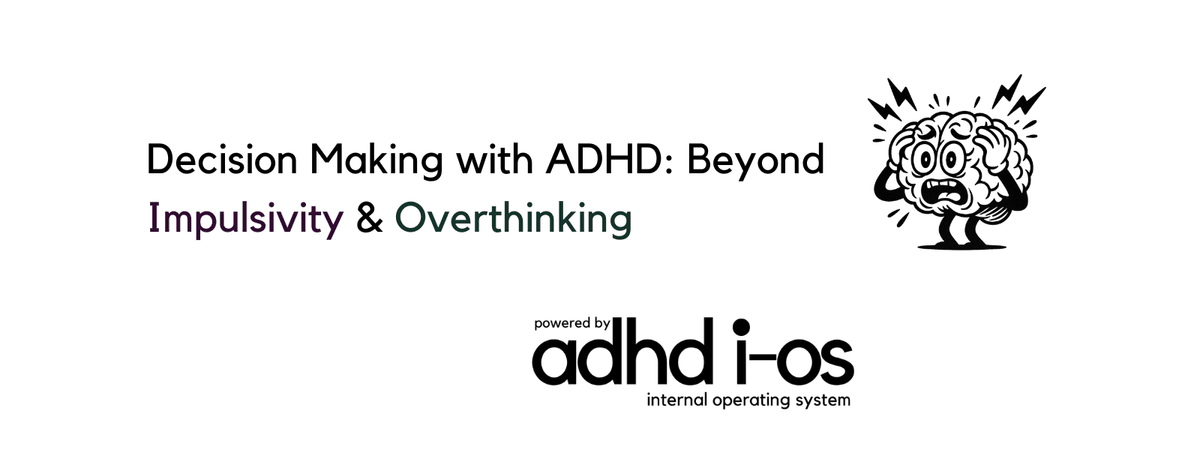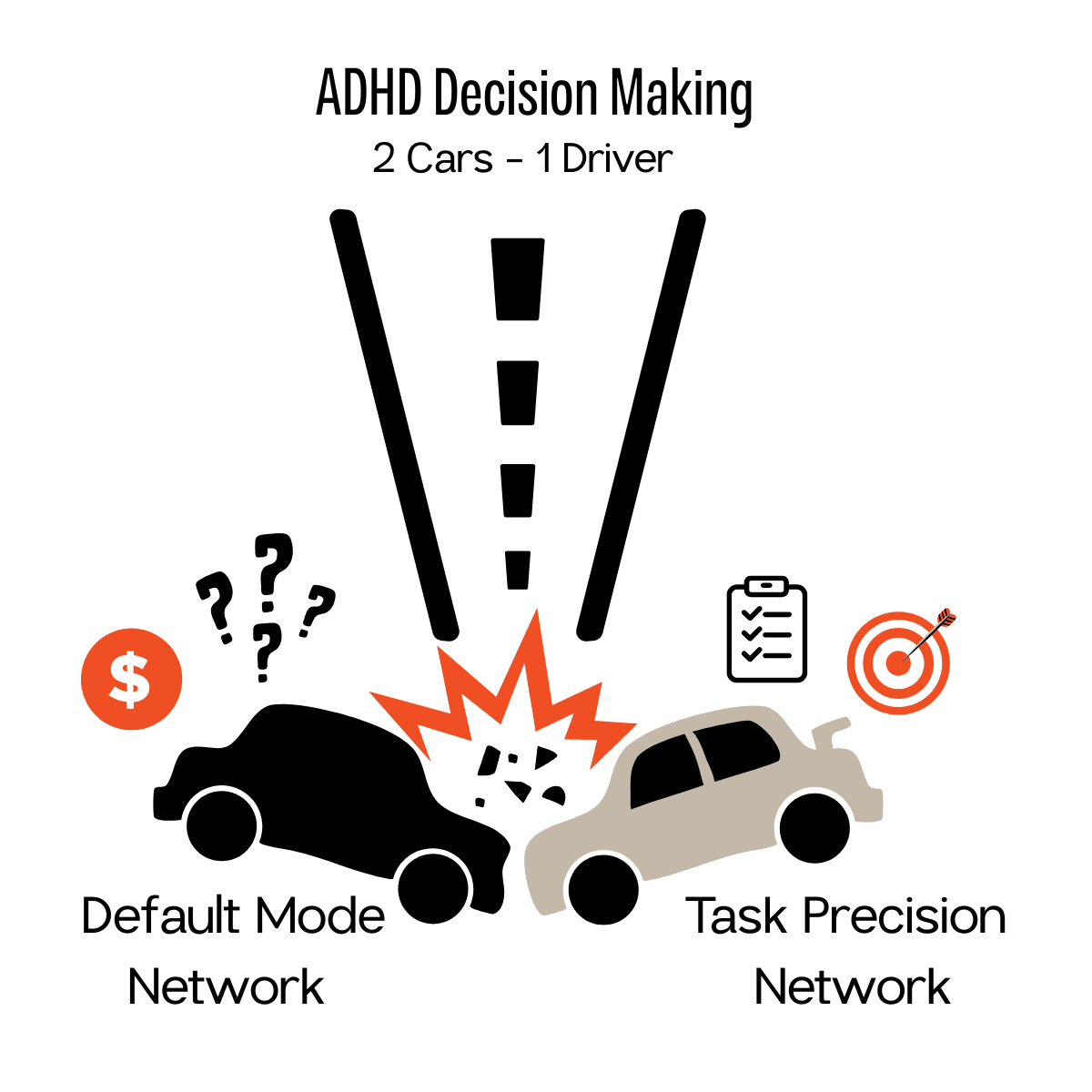Decision Making with ADHD: Beyond Impulsivity & Overthinking
Decision Making with ADHD: Beyond Impulsivity & Overthinking
Decision Making with ADHD: Beyond Impulsivity & Overthinking
Entrepreneurs make dozens of decisions every day, but how many of them stand the test of time?
If you're like most business owners with ADHD, you're probably stuck in one of two decision-making patterns: either rushing toward choices that feel exciting in the moment, or tunneling into the research rabbit hole, until decision fatigue wins and you choose nothing at all.
There's a better way.
Understanding how your ADHD brain works, specifically what's happening with something called your Default Mode Network, can help you stop defaulting to novelty and urgency or analysis paralysis and missed opportunities. More importantly, it gives you a roadmap for creating sustainable systems that lead to better decision outcomes.

Why the ADHD Brain Creates Decision Defaults for Less Than Optimal Outcomes
Let's start with the uncomfortable truth: your ADHD brain is basically wired to make decision-making harder than it needs to be. But this isn't a character flaw, it's neurobiology.
Think of it as your brain's screensaver, except it's more like that annoying colleague who interrupts every meeting with random thoughts and hijacks the conversation with irrelevant tangents.
The Science Behind the Chaos: What Research Shows
Research published in NeuroImage: Clinical, examining adults with ADHD, shows that excessive activity of the DMN is evident in ADHD and associated with poor decision-making. The study found that adults with ADHD exhibit more variable DMN activation patterns during decision-making tasks compared to healthy controls.
Here’s what this means in practical terms: when you're trying to decide whether to invest in that new software or pivot your business strategy, your DMN is running a completely different program in the background. It's pulling up memories of past failures, generating worries about cash flow, spinning creative tangents about completely unrelated opportunities, and generally making it impossible for your prefrontal cortex, your brain’s actual decision-making center, to do its job. Sound familiar?
In neurotypical brains, there's a polite handoff between the DMN and what's called the Task Positive Network (the focused-work network). When one turns on, the other turns off.
In ADHD brains? They're both trying to drive the car at the same time.
No wonder decision-making often feels daunting or like you're not the one at the wheel.

Two Predictable Patterns That Emerge
Default Pattern One: Impulsive Decisions (DMN Overwhelm)
When your DMN is particularly chaotic, you'll make rapid decisions just to escape the mental chaos. A 2024 study published in CNS Neuroscience & Therapeutics found increased interference among brain networks in adults with ADHD.
This is why you might impulsively sign up for that expensive course you don’t need, hire that consultant without properly vetting them, or completely restructure your business because of something you heard on a podcast. Your brain is literally trying to quiet the noise by making fast choices
Spoiler alert: they aren’t choices, just impulses with consequences.
Default Pattern Two: Analysis Paralysis (DMN Rumination)
On the flip side, some ADHD brains respond to network interference by overcorrecting. If you can't trust your impulses, the logical response is to research everything to death.
This is the 37-browser-tabs style of decision-making.
You end up researching project management platforms for three weeks and still can't decide.
Both patterns stem from the same root cause: your DMN won’t stay in its lane, making it nearly impossible for your prefrontal cortex to execute clear, confident decisions.
Which Factors to Consider if We Want to Shift Our Decision-Making Default
Three Critical Factors That Influence Your Decision-Making
The good news? You can work with your brain’s wiring once you understand what triggers your particular decision-making pattern.
Factor One: Decision Complexity vs. DMN Interference
Quick, routine decisions (like when to check email) don’t trigger major DMN interference. Complex decisions (like hiring your first employee) do. But the pattern isn’t always logical.
A $50 tool might send you into a three-hour spiral, while a $5,000 investment is made in five minutes.
Factor Two: Your Executive Function Baseline
Decision-making depends on executive function, which ADHD brains already spend managing everyday tasks. Consider these influences:
- Sleep
- Hydration
- Meals
- Stress level
- Number of decisions already made today
Stop trying to make important business decisions when your executive function tank is already empty.

Factor Three: Environmental and Emotional Context
If you're anxious or distracted, your DMN will pull up past failures or tempt you toward distraction. ADHD entrepreneurs learn to notice these contextual cues and adapt.
What Steps to Take to Start Creating New Neural Pathways for Better Decisions
You can't rewire your brain overnight, but you can build systems that reduce chaos.
Step One: Implement Decision Triage
Stop treating all decisions like they're life-or-death.
Create three categories:
- Low Stakes (Under 5 mins) – Trust your gut and move on.
- Medium Stakes (2 hours–2 days) – Set limits and 3 decision criteria.
- High Stakes (1 week–1 month) – Bring in a mentor or advisor.

Step Two: Create DMN Management Protocols
You can train your brain to handle interference. Try:
- Name the interference: Say “DMN takeover” out loud.
- Physical reset: Move, stretch, or breathe deeply for 30 seconds.
- Time-box tasks: ADHD brains thrive with boundaries.
Step Three: Build Decision-Making Confidence Through Data
Track your decisions:
- Date
- What you decided
- Expected vs. actual outcomes
- What you learned
If writing is too much, use voice notes. You’re better at this than you think.
Step Four: Design Your Environment for Success
Your environment affects your brain. Try this:
- Use templates and checklists
- Limit decision options
- Schedule big decisions for when you're mentally fresh
The Bottom Line: Accept, Forgive, and Improve Over Time
Understanding your brain’s default patterns helps you stop blaming yourself. The DMN isn’t the enemy, it’s a powerful network for creativity and innovation.
Your brain may be wired differently, but with the right systems and understanding, those differences become advantages rather than obstacles.
Every successful entrepreneur with ADHD has learned this fundamental truth: you can't think your way out of decision-making challenges, but you can systematize your way through them.
About Diann Wingert

Diann Wingert is a former psychotherapist, serial business owner, and coach who helps neurodivergent entrepreneurs focus, follow through, and finish what they start, while leveraging their ADHD as a business asset.
Diann hosts the ADHD-ish Podcast, is a practicing Buddhist, and loves strong coffee, rescue dogs, and laughing out loud. She is passionate about helping neurodivergent individuals achieve financial independence through entrepreneurship, balancing passion and purpose with profit.
Called “The Speaker of Uncomfortable Truths,” Diann believes neurodiversity is the source of creativity, imagination, and innovation.
Sources:
1. Sripada, C., et al. (2017). Increased default-mode variability is related to reduced task performance and is evident in adults with ADHD. NeuroImage: Clinical, 16, 369-382.
2. Liu, L., et al. (2024). Interference of default mode on attention networks in adults with attention-deficit/hyperactivity disorder and its association with genetic variants and treatment outcomes. CNS Neuroscience & Therapeutics, 30(8), e14900.
3. Ramos-Galarza, C., et al. (2024). Systematic Review of Executive Function Stimulation Methods in the ADHD Population. Journal of Clinical Medicine, 13(14), 4208.

